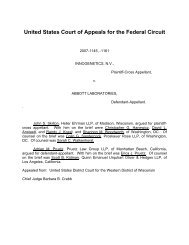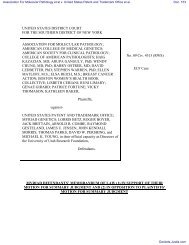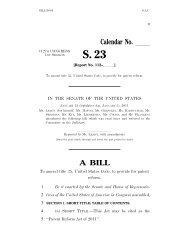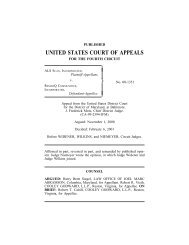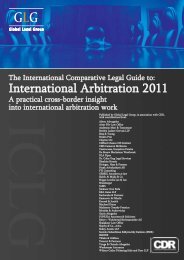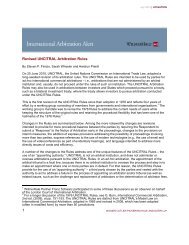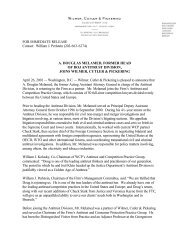2008 IPO Report - Initial Public Offerings
2008 IPO Report - Initial Public Offerings
2008 IPO Report - Initial Public Offerings
Create successful ePaper yourself
Turn your PDF publications into a flip-book with our unique Google optimized e-Paper software.
12 New SEC Rules Offer Some Relief to Smaller <strong>Public</strong> CompaniesEffective February 4, <strong>2008</strong>, the SECpromulgated a new set of disclosurerules for “smaller reporting companies”to replace the former “small businessissuer” rules. A smaller reporting companyis eligible to use reduced, or “scaled,”disclosure in the Form S-1 registrationstatement for its <strong>IPO</strong> and in subsequentSEC filings.EligibilityUnder the new rules, a smaller reportingcompany must have a public float of lessthan $75 million. An <strong>IPO</strong> companydetermines its eligibility as of a datewithin 30 days of the initial Form S-1filing. <strong>Public</strong> float is calculated bymultiplying a bona fide estimate of the<strong>IPO</strong> offering price per share (which neednot be disclosed) by the sum of the numberof outstanding shares of common stockheld by non-affiliates before the <strong>IPO</strong> plusthe aggregate number of shares beingregistered for sale in the <strong>IPO</strong>.An existing public company determinesits eligibility by measuring its publicfloat as of the last day of its most recentlycompleted second fiscal quarter. <strong>Public</strong>float is calculated by multiplying themarket price of its common stock bythe number of shares held by non-affiliatesof the company. If the company’s publicfloat is $75 million or more on that date,it cannot qualify as a smaller reportingcompany until such point as its publicfloat as of the last day of a second fiscalquarter falls below $50 million.If the public float of a smaller reportingcompany as of the last day of its secondfiscal quarter rises to $75 millionor more, the company can no longer usescaled disclosure beginning with theForm 10-Q for the first fiscal quarterof the next fiscal year. The company may,however, continue to use scaled disclosurethrough and including the filing of itsForm 10-K for that fiscal year. To regaineligibility thereafter, the company’s publicfloat as of the last day of a second fiscalquarter must fall below $50 million.If a company is unable to calculateits public float—for example, if it has nocommon stock outstanding or no marketprice exists for its outstanding commonstock—it must have had less than $50million in revenue in its most recent fiscalyear to qualify as a smaller reportingcompany. Once its annual revenue exceeds$50 million, the company will lose itssmaller reporting company status untilit has annual revenue of less than $40million in its most recent fiscal year.Scaled DisclosureThe accompanying table summarizesthe scaled disclosure that is availableto smaller reporting companies underRegulation S-K—the source of manydisclosure requirements in SEC filings.In addition, smaller reporting companiesare permitted to provide one fewer yearof audited statements of income, cashflows and changes in stockholders’ equity.Smaller reporting companies are allowedto pick and choose on an item-by-item(referred to as “à la carte”) basis the aspectsof scaled disclosure they wish to follow,and can make this election quarterly.ImplicationsRelatively few <strong>IPO</strong> companies will qualifyas smaller reporting companies, since most<strong>IPO</strong>s—particularly underwritten ones—have an anticipated public float of at least$75 million. Over time, however, somepost-<strong>IPO</strong> companies may find themselveseligible to provide scaled disclosure astheir fortunes—and public floats—wane.Scaled disclosure, if available, can providesignificant savings in terms of expenseand preparation time. The principaladvantages relate to financial statementsand executive compensation disclosure.Smaller reporting companies are notrequired to provide segment information,selected financial data, supplementaryfinancial information or information aboutmarket risk, and can provide one feweryear of audited financial statements andthe associated discussion in MD&A. Scaleddisclosure permits much less extensiveexecutive compensation information,including no CD&A, and requires onlythree of the seven compensation tablesthat would otherwise be required.If a company qualifies as a smallerreporting company, it should considerthe following questions when decidingwhether, and to what extent,it will provide scaled disclosure:■Does the company wish to beperceived by the market as a “smaller”company? If not, the company maywish to forego scaled disclosure.■What disclosures does the company’sinvestor base expect? If the company’sinvestors are largely institutional,they may be dissatisfied by the lessextensive disclosure permitted by thesmaller reporting company rules.■What disclosures are the company’scompetitors making? If the company’sprincipal competitors prepare their SECfilings on the basis of the larger reportingcompany rules, the company may bedisadvantaged if it does not do the same.■Does the company believe that itsstatus as a smaller reporting companyis temporary? If so, the company maywish to eschew scaled disclosureto avoid any issues with the consistencyand comparability of its disclosuresbefore and after its stint as a smallerreporting company.■Have there been any material changesto the company’s financial position,business or executive compensation thatwould be masked by scaled disclosure?If so, the company should consider theSEC’s antifraud rules and be mindfulof any appearance that it is attemptingto hide material information throughthe use of scaled disclosure.■Would scaled disclosure subject thecompany to additional potential liabilityunder the securities laws, or denyit the benefits of additional cautionarydisclosures? For example, althoughsmaller reporting companies mayomit risk factors from Forms 10, 10-Qand 10-K, doing so may be unwise.In the context of an <strong>IPO</strong>, the company’sdecision should be made in consultationwith the lead underwriters. In many cases,the underwriters are likely to concludethat the marketing of the offering wouldbe enhanced if the company were toprovide more comprehensive disclosurein lieu of scaled disclosure.





